Figure of Merit Enhancement of Laterally Vibrating RF-MEMS Resonators via Energy-Preserving Addendum Frame
Abstract
1. Introduction
2. Energy-Preserving Suspended Addendum Frame
2.1. Mechanical Equivalent Model
2.2. Transmissibility Analysis
3. Device Design and Simulation
4. Discussion
5. Spurious Mode Suppression
6. Conclusions
Author Contributions
Funding
Conflicts of Interest
References
- Tu, C.; Lee, J. Enhancing quality factor by etch holes in piezoelectric-on-silicon lateral mode resonators. Sens. Actuators A Phys. 2017, 259, 144–151. [Google Scholar] [CrossRef]
- Piazza, G.; Stephanou, P.J.; Pisano, A.P. Piezoelectric Aluminum Nitride Vibrating Contour-Mode MEMS Resonators. J. Microelectromech. Syst. 2006, 15, 1406–1418. [Google Scholar] [CrossRef]
- Lee, J.-I.; Jeong, B.; Park, S.; Eun, Y.; Kim, J. Micromachined Resonant Frequency Tuning Unit for Torsional Resonator. Micromachines 2017, 8, 342. [Google Scholar] [CrossRef]
- Nguyen, C.T.-C. MEMS technology for timing and frequency control. IEEE Trans. Ultrason. Ferroelectr. Freq. Control 2007, 54, 251–270. [Google Scholar] [CrossRef]
- Jmai, B.; Rajhi, A.; Gharsallah, A. Novel Conception of a Tunable RF MEMS Resonator. Int. J. Adv. Comput. Sci. Appl. 2017, 8. [Google Scholar] [CrossRef]
- Jiang, S.; Hu, H.; Laude, V. Low-frequency band gap in cross-like holey phononic crystal strip. J. Phys. D Appl. Phys. 2017, 51, 045601. [Google Scholar] [CrossRef]
- Feng, D.; Xu, D.; Wu, G.; Xiong, B.; Wang, Y. Phononic crystal strip based anchors for reducing anchor loss of micromechanical resonators. J. Appl. Phys. 2014, 115, 024503. [Google Scholar] [CrossRef]
- Li, X.; Huang, Y.; Du, Y.; Li, Z.; Bao, F.; Bao, J. Study of a 10 MHz MEMS oscillator with a TPoS resonator. Sens. Actuators A Phys. 2017, 258, 59–67. [Google Scholar] [CrossRef]
- Baghelani, M.; Ghavifekr, H.B.; Ebrahimi, A. Crossed ring anchored disk resonator for self-alignment of the anchor. J. Adv. Res. 2013, 5, 109–115. [Google Scholar] [CrossRef] [PubMed]
- Gao, A.; Liu, K.; Liang, J.; Wu, T. AlN MEMS filters with extremely high bandwidth widening capability. Microsyst. Nanoeng. 2020, 6, 1–11. [Google Scholar] [CrossRef] [PubMed]
- Xu, C.; Piazza, G. Active Boost in the Quality Factor of an AlN MEMS Resonator up to 165,000. In Proceedings of the 2019 IEEE 32nd International Conference on Micro Electro Mechanical Systems (MEMS), Seoul, Korea, 27–31 January 2019; pp. 907–910. [Google Scholar] [CrossRef]
- Zafar, L.R.; Huang, J.; Khan, M.A. Quality enhancement and insertion loss reduction of a rectangular resonator by employing an ultra-wide band gap diamond phononic crystal. Chin. J. Phys. 2020, 65, 481–490. [Google Scholar] [CrossRef]
- Wu, G.; Zhu, Y.; Merugu, S.; Wang, N.; Sun, C.; Gu, Y. GHz spurious mode free AlN lamb wave resonator with high figure of merit using one dimensional phononic crystal tethers. Appl. Phys. Lett. 2016, 109, 013506. [Google Scholar] [CrossRef]
- Segovia-Fernandez, J.; Cremonesi, M.; Cassella, C.; Frangi, A.; Piazza, G. Anchor Losses in AlN Contour Mode Resonators. J. Microelectromech. Syst. 2014, 24, 265–275. [Google Scholar] [CrossRef]
- Kim, H.J.; Segovia-Fernandez, J.; Piazza, G. The Impact of Damping on Flicker Frequency Noise of AlN Piezoelectric MEMS Resonators. J. Microelectromech. Syst. 2017, 26, 1–8. [Google Scholar] [CrossRef]
- Rabih, A.A.S.; Dennis, J.O.; Khir, M.H.M.; Abdullah, M.A. Design, modeling and simulation of CMOS-MEMS resonator for biomedical application. In Proceedings of the 2014 5th International Conference on Intelligent and Advanced Systems (ICIAS), Kuala Lumpur, Malaysia, 3–5 June 2014; pp. 1–6. [Google Scholar] [CrossRef]
- Pfusterschmied, G.; Toledo, J.; Kucera, M.; Steindl, W.; Zemann, S.; Ruiz-Díez, V.; Schneider, M.; Bittner, A.; Sanchez-Rojas, J.L.; Schmid, U. Potential of Piezoelectric MEMS Resonators for Grape Must Fermentation Monitoring. Micromachines 2017, 8, 200. [Google Scholar] [CrossRef] [PubMed]
- Zou, J.; Lin, C.-M.; Lam, C.S.; Pisano, A.P. Transducer design for AlN Lamb wave resonators. J. Appl. Phys. 2017, 121, 154502. [Google Scholar] [CrossRef]
- Liang, J.; Zhang, H.; Zhang, D.; Duan, X.; Zhang, H.; Pang, W. Design and fabrication of aluminum nitride Lamb wave resonators towards high figure of merit for intermediate frequency filter applications. J. Micromech. Microeng. 2015, 25. [Google Scholar] [CrossRef]
- Zhu, Y.; Wang, N.; Sun, C.; Merugu, S.; Singh, N.; Gu, Y. A High Coupling Coefficient 2.3-GHz AlN Resonator for High Band LTE Filtering Application. IEEE Electron. Device Lett. 2016, 37, 1344–1346. [Google Scholar] [CrossRef]
- Dong, L.; Tao, J.; Bao, J.; Zhao, W.-S.; Wang, G. Anchor Loss Variation in MEMS Wine-Glass Mode Disk Resonators Due to Fluctuating Fabrication Process. IEEE Sens. J. 2016, 16, 6846–6856. [Google Scholar] [CrossRef]
- Harrington, B.P.; Abdolvand, R. In-plane acoustic reflectors for reducing effective anchor loss in lateral–extensional MEMS resonators. J. Micromech. Microeng. 2011, 21. [Google Scholar] [CrossRef]
- Ardito, R.; Cremonesi, M.; D’Alessandro, L.; Frangi, A. Application of optimally-shaped phononic crystals to reduce anchor losses of MEMS resonators. In Proceedings of the 2016 IEEE International Ultrasonics Symposium (IUS), Tours, France, 18–21 September 2016; pp. 1–3. [Google Scholar] [CrossRef]
- Tu, C.; Lee, J. VHF-band biconvex AlN-on-silicon micromechanical resonators with enhanced quality factor and suppressed spurious modes. J. Micromech. Microeng. 2016, 26, 065012. [Google Scholar] [CrossRef]
- Siddiqi, M.W.U.; Tu, C.; Lee, J.E.-Y. Effect of mode order, resonator length, curvature, and electrode coverage on enhancing the performance of biconvex resonators. J. Micromech. Microeng. 2018, 28, 094002. [Google Scholar] [CrossRef]
- Lin, C.-M.; Lai, Y.-J.; Hsu, J.-C.; Chen, Y.-Y.; Senesky, D.; Pisano, A.P. High-Q aluminum nitride Lamb wave resonators with biconvex edges. Appl. Phys. Lett. 2011, 99, 143501. [Google Scholar] [CrossRef]
- Siddiqi, M.W.U.; Lee, J.E.-Y. Quality Factor Enhancement of AlN-on-Si Lamb Wave Resonators Using a Hybrid of Phononic Crystal Shapes in Anchoring Boundaries. In Proceedings of the 2019 20th International Conference on Solid-State Sensors, Actuators and Microsystems & Eurosensors XXXIII (TRANSDUCERS & EUROSENSORS XXXIII), Berlin, Germany, 23–27 June 2019; pp. 913–916. [Google Scholar] [CrossRef]
- Ha, T.D.; Bao, J. A phononic crystal strip based on silicon for support tether applications in silicon-based MEMS resonators and effects of temperature and dopant on its band gap characteristics. AIP Adv. 2016, 6, 045211. [Google Scholar] [CrossRef]
- Workie, T.B.; Wu, T.; Bao, J.; Hashimoto, K. Q-factor enhancement of MEMS Resonators with Ditetragonal Prism shaped Phononic Crystal (DTP-PnC). In USE; USE 2020|Contents: Osaka, Japan, 2020; Volume 41, p. 2E5-2. Available online: Use-dl.org (accessed on 6 July 2021).
- Ash, B.J.; Worsfold, S.R.; Vukusic, P.; Nash, G.R. A highly attenuating and frequency tailorable annular hole phononic crystal for surface acoustic waves. Nat. Commun. 2017, 8, 1–7. [Google Scholar] [CrossRef] [PubMed]
- Workie, T.B.; Liu, J.; Wu, Z.; Tang, P.; Bao, J.-F.; Hashimoto, K.-Y. Swastika Hole shaped Phononic Crystal for Quality enhancement of Contour Mode Resonators. In Proceedings of the 2021 IEEE MTT-S International Wireless Symposium (IWS), Nanjing, China, 23–26 May 2021; pp. 1–3. [Google Scholar] [CrossRef]
- Workie, T.B.; Wu, T.; Bao, J.-F.; Hashimoto, K.-Y. Design for high-quality factor of piezoelectric-on-silicon MEMS resonators using resonant plate shape and phononic crystals. Jpn. J. Appl. Phys. 2021, 60, SDDA03. [Google Scholar] [CrossRef]
- Liu, J.; Workie, T.B.; Wu, Z.; Tang, P.; Bao, J.-F.; Hashimoto, K.-Y. Acoustic Reflectors for Anchor Loss Reduction of Thin Film Piezoelectric on Substrate Resonators. In Proceedings of the 2021 IEEE MTT-S International Wireless Symposium (IWS), Nanjing, China, 23–26 May 2021; pp. 1–3. [Google Scholar] [CrossRef]
- Pulskamp, J.S.; Bedair, S.S.; Polcawich, R.G.; Judy, D.; Bhave, S.A. Ferroelectric PZT RF MEMS resonators. In Proceedings of the Joint Conference of the IEEE International Frequency Control and the European Frequency and Time Forum (FCS) Proceedings, San Francisco, CA, USA, 2–5 May 2011. [Google Scholar]
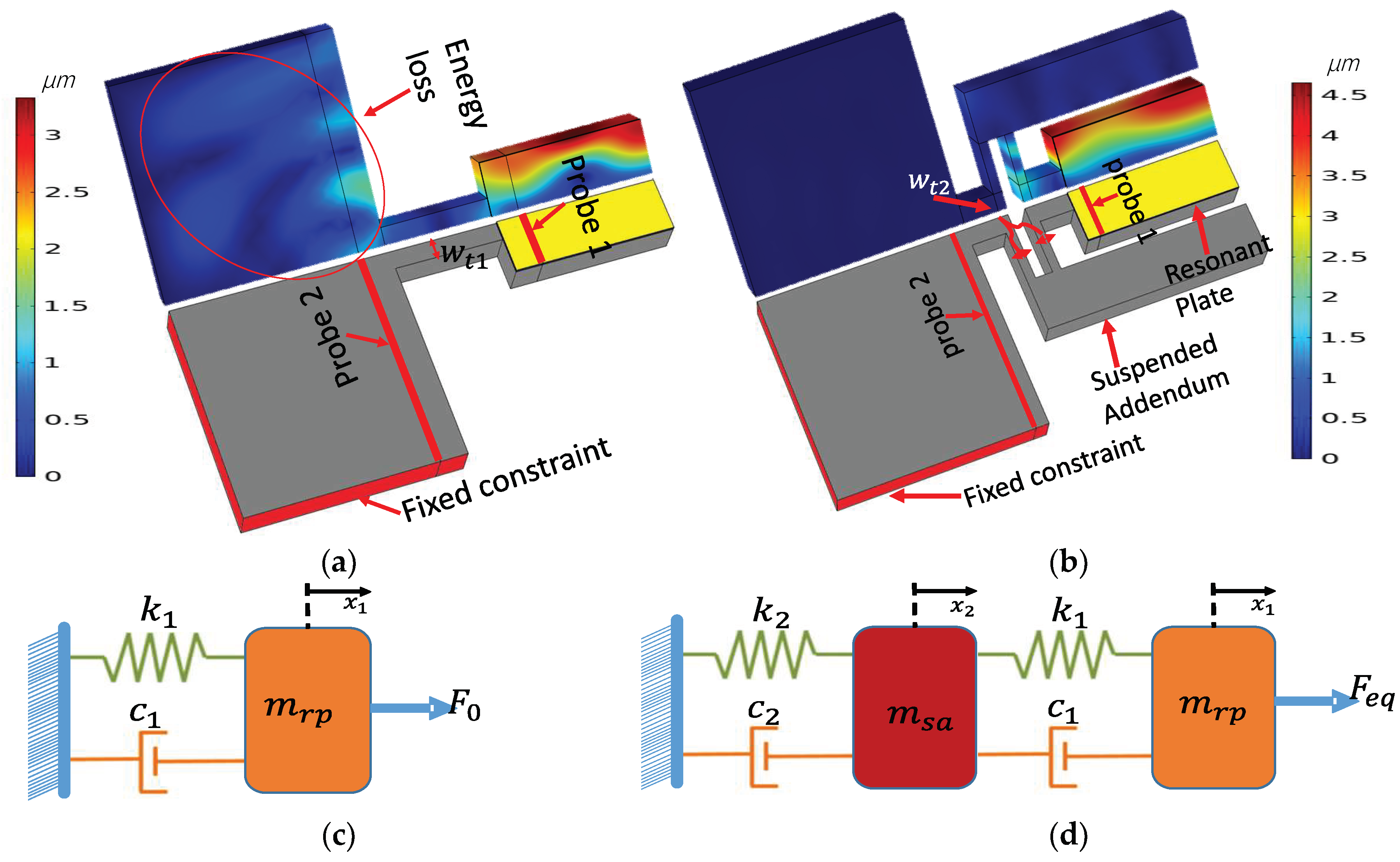
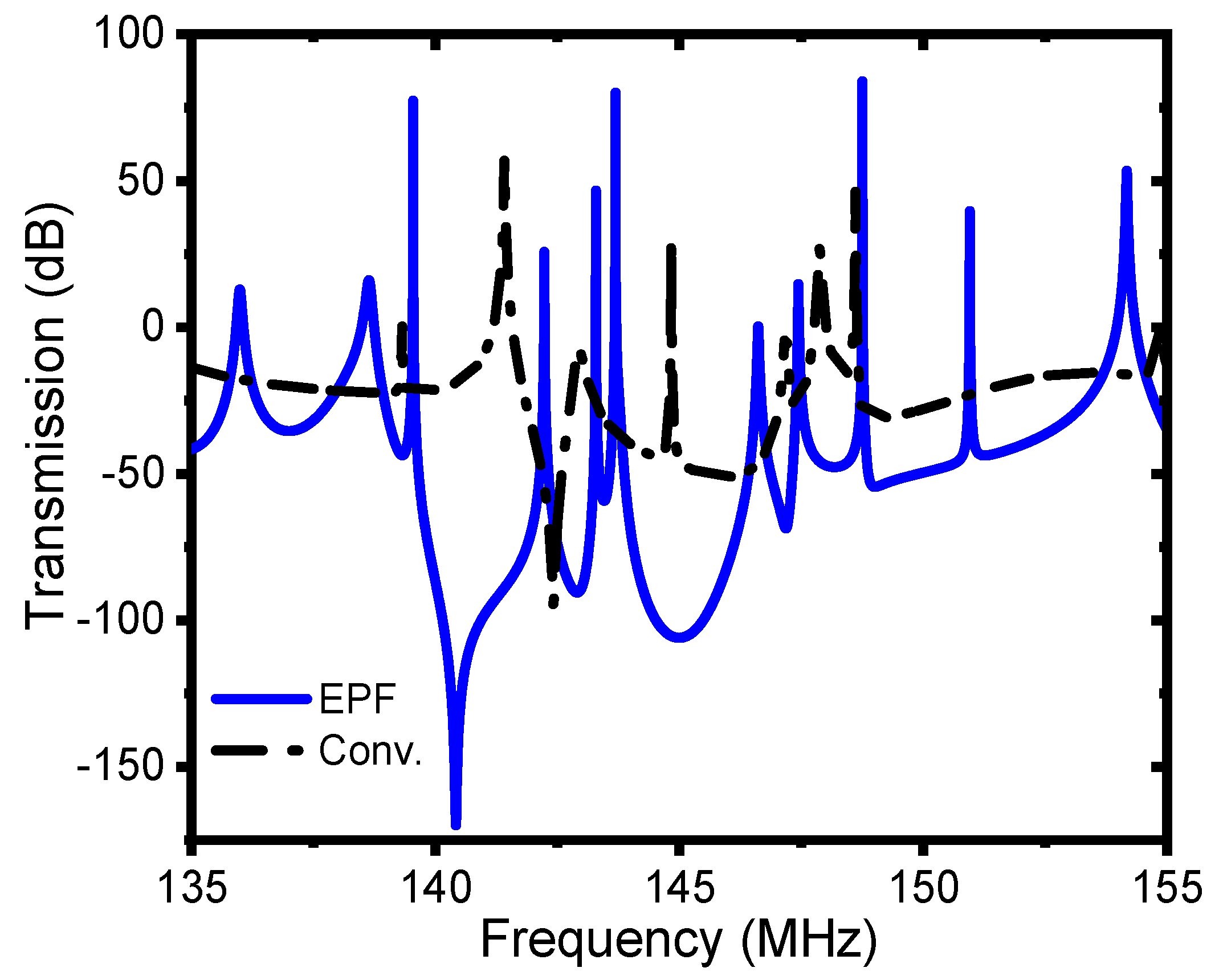
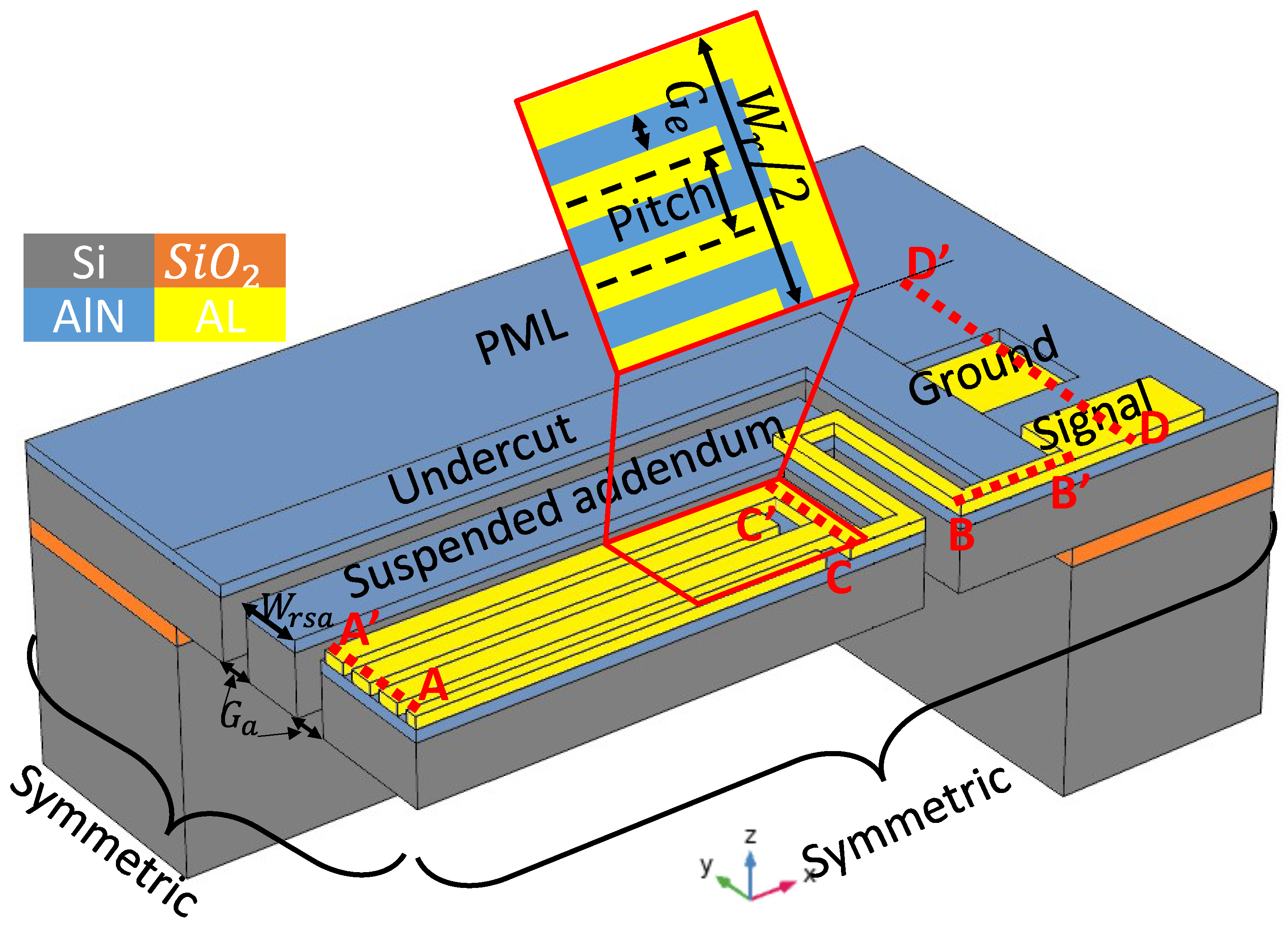

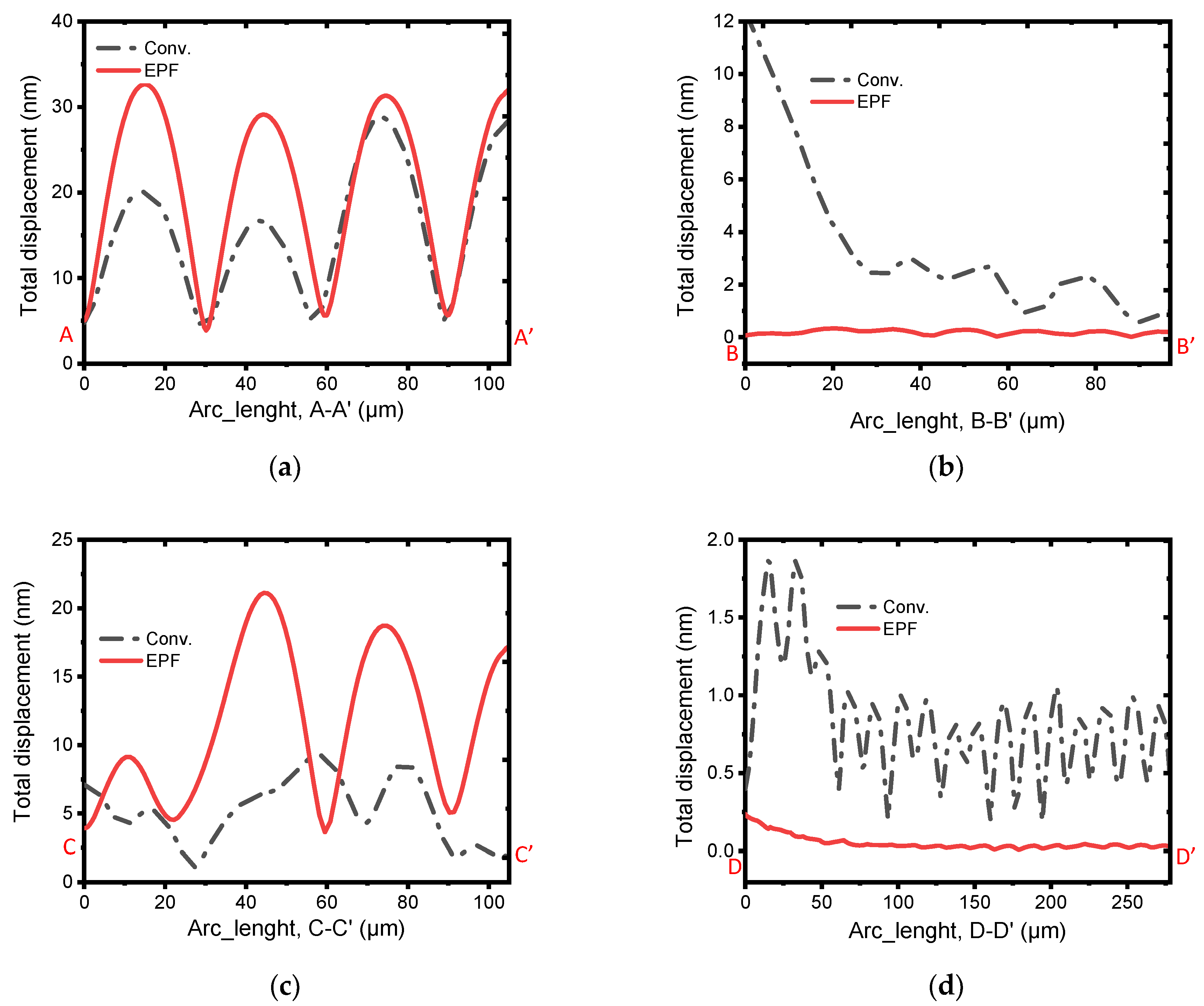
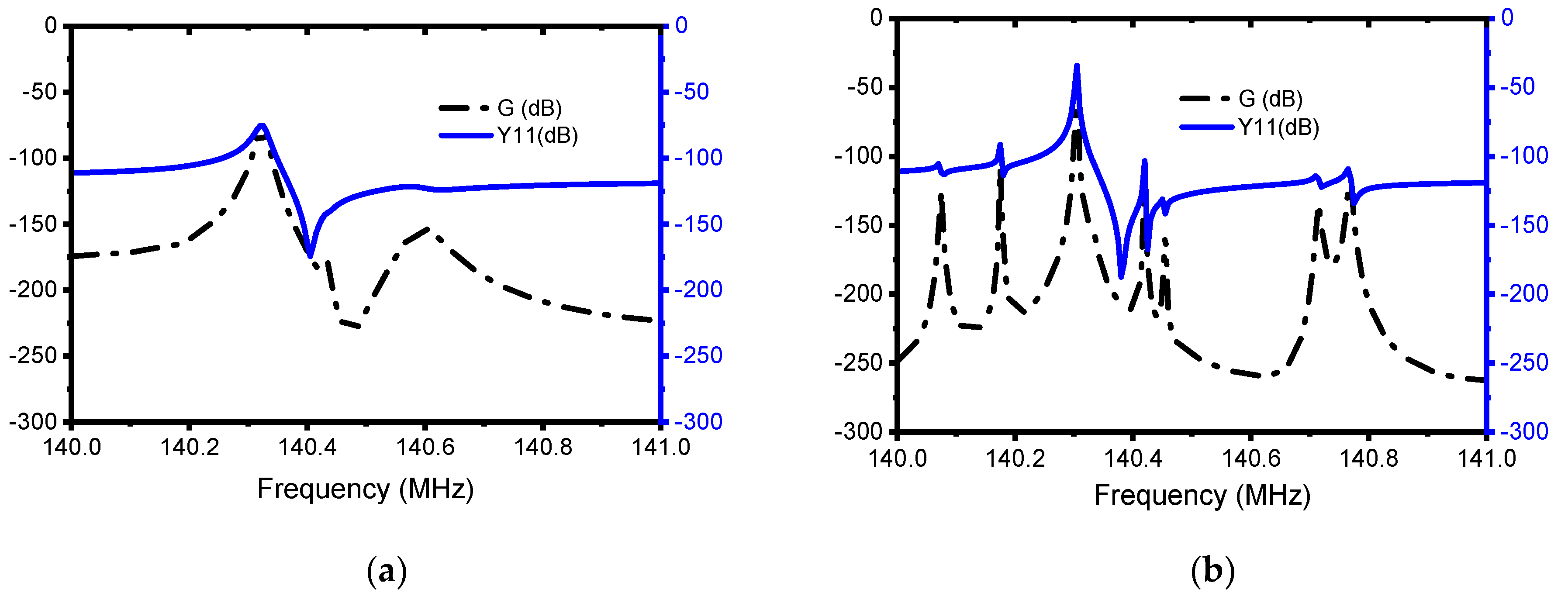
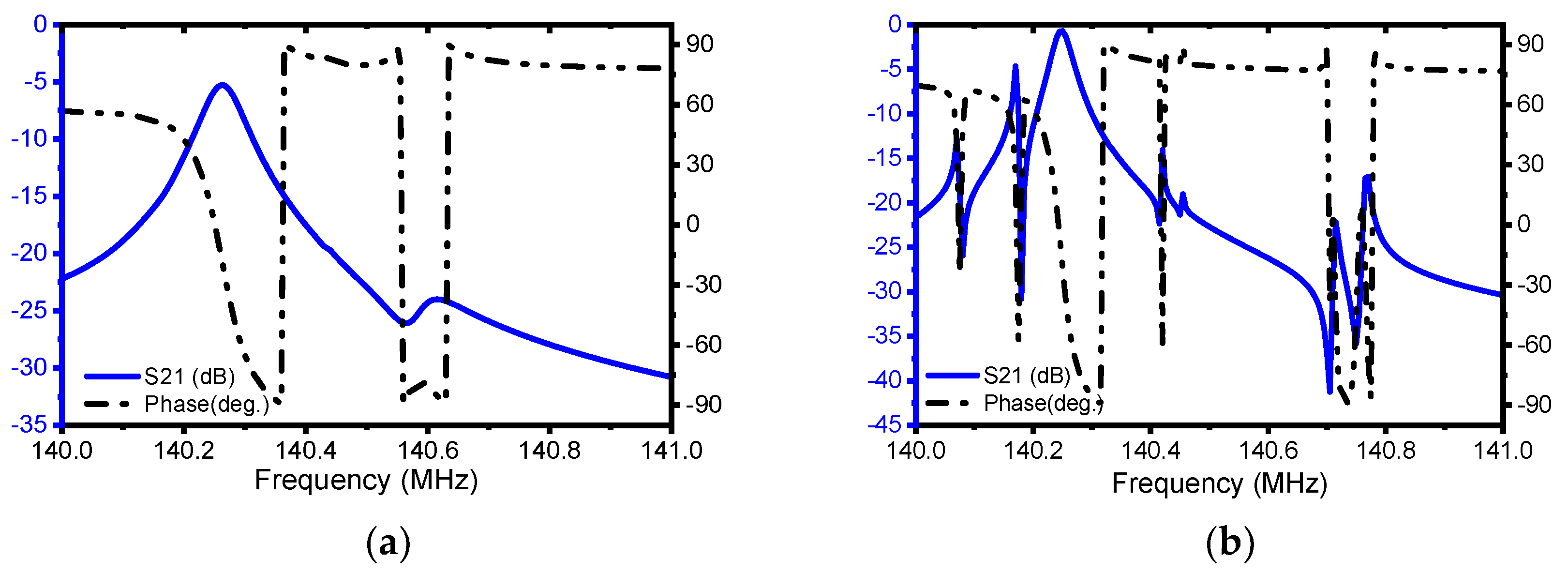
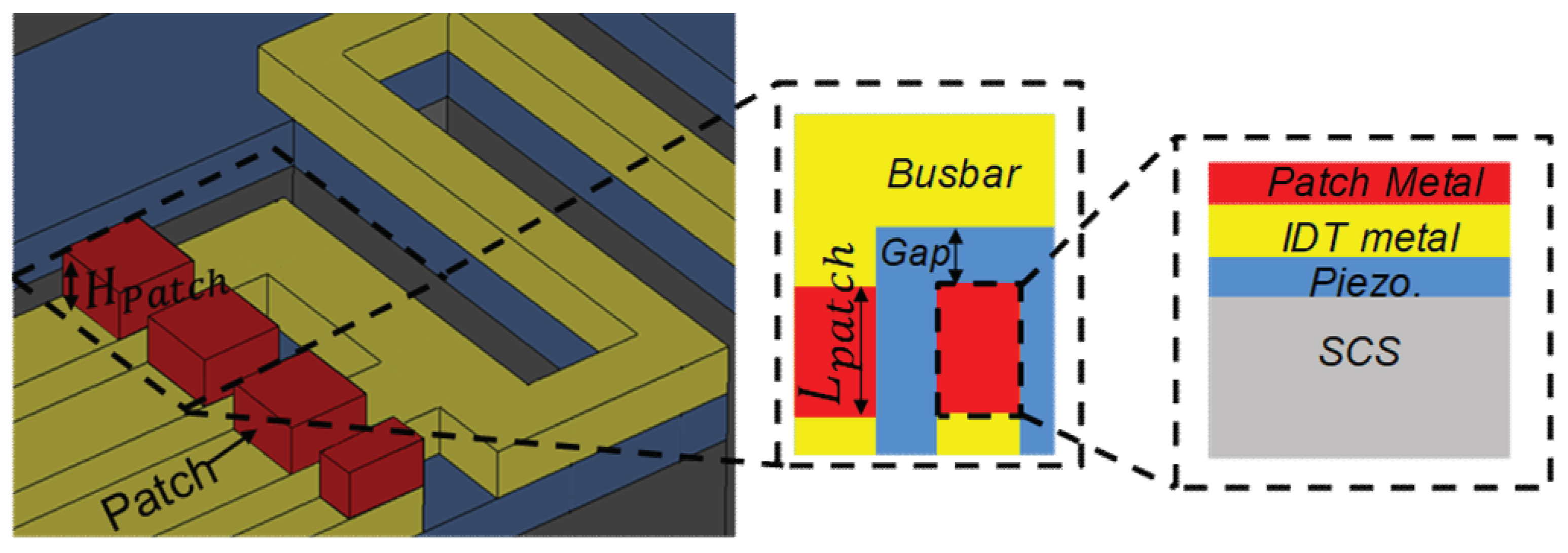
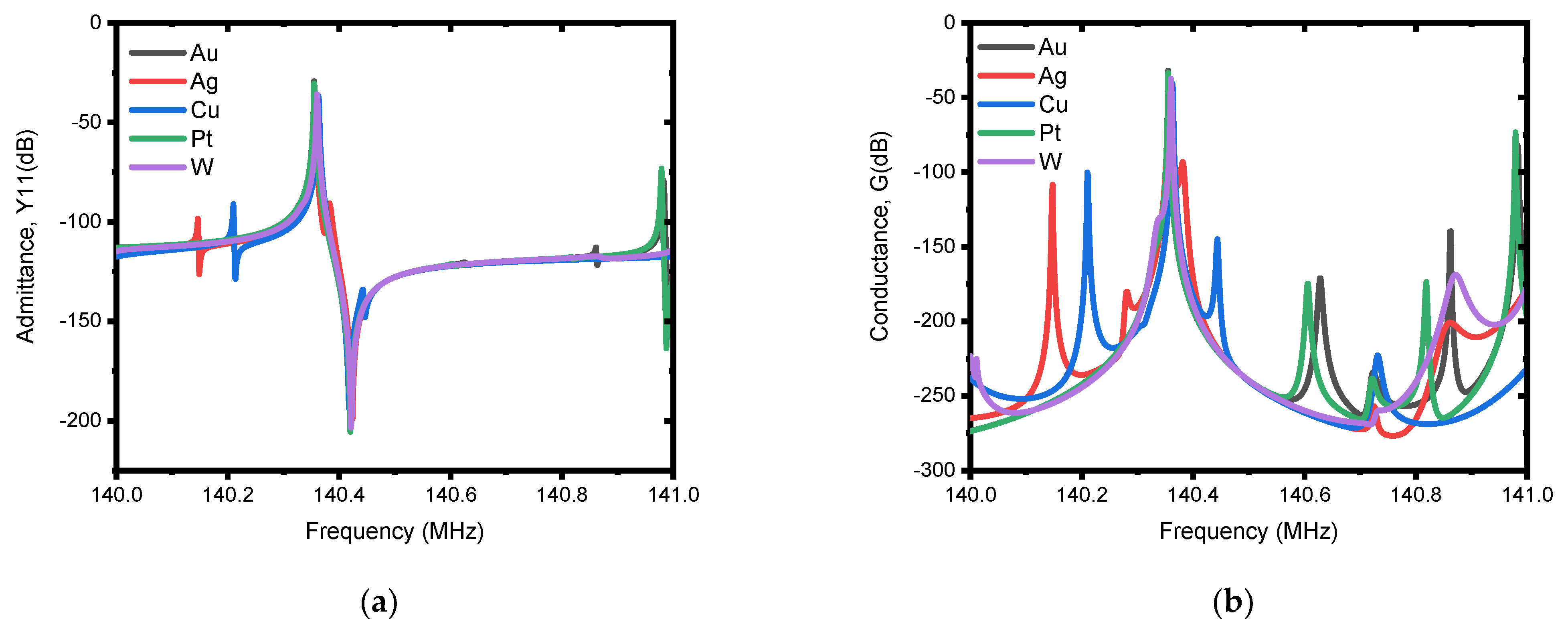


| Symbol | Dimension | Value (µm) |
|---|---|---|
| Width of resonator | 211.4 | |
| Length of resonator | 740 | |
| Substrate thickness | 10 | |
| Piezoelectric material thickness | 0.1 | |
| Electrode thickness | 1 | |
| pitch | Electrode pitch width | 30.2 |
| Width of IDT fingers | 26.2 | |
| Length of tether | 120 | |
| Width of tether | 40 | |
| Width of undercut | 60.4 | |
| Width of suspended addendum | 60.4 | |
| Width of meandering tether | 10 | |
| Gap of addendums | 42 |
| Device | IL (dB) | FoM | |||
|---|---|---|---|---|---|
| Conventional | 5.28 | 1870 | 4106 | 0.14 | 6 |
| EPF | 0.7 | 4007 | 51,136 | 0.13 | 66 |
| Properties | Ag | Cu | Au | Pt | W |
|---|---|---|---|---|---|
| Density ) | 10.5 | 8.94 | 19.32 | 21.4 | 18.7 |
| Longitudinal velocity | 3.2 | 4.65 | 3.24 | 3.96 | 5.23 |
| Acoustic impedance | 37.8 | 41.55 | 62.6 | 84.74 | 97.86 |
Publisher’s Note: MDPI stays neutral with regard to jurisdictional claims in published maps and institutional affiliations. |
© 2022 by the authors. Licensee MDPI, Basel, Switzerland. This article is an open access article distributed under the terms and conditions of the Creative Commons Attribution (CC BY) license (https://creativecommons.org/licenses/by/4.0/).
Share and Cite
Workie, T.B.; Wu, Z.; Tang, P.; Bao, J.; Hashimoto, K.-y. Figure of Merit Enhancement of Laterally Vibrating RF-MEMS Resonators via Energy-Preserving Addendum Frame. Micromachines 2022, 13, 105. https://doi.org/10.3390/mi13010105
Workie TB, Wu Z, Tang P, Bao J, Hashimoto K-y. Figure of Merit Enhancement of Laterally Vibrating RF-MEMS Resonators via Energy-Preserving Addendum Frame. Micromachines. 2022; 13(1):105. https://doi.org/10.3390/mi13010105
Chicago/Turabian StyleWorkie, Temesgen Bailie, Zhaohui Wu, Panliang Tang, Jingfu Bao, and Ken-ya Hashimoto. 2022. "Figure of Merit Enhancement of Laterally Vibrating RF-MEMS Resonators via Energy-Preserving Addendum Frame" Micromachines 13, no. 1: 105. https://doi.org/10.3390/mi13010105
APA StyleWorkie, T. B., Wu, Z., Tang, P., Bao, J., & Hashimoto, K.-y. (2022). Figure of Merit Enhancement of Laterally Vibrating RF-MEMS Resonators via Energy-Preserving Addendum Frame. Micromachines, 13(1), 105. https://doi.org/10.3390/mi13010105









